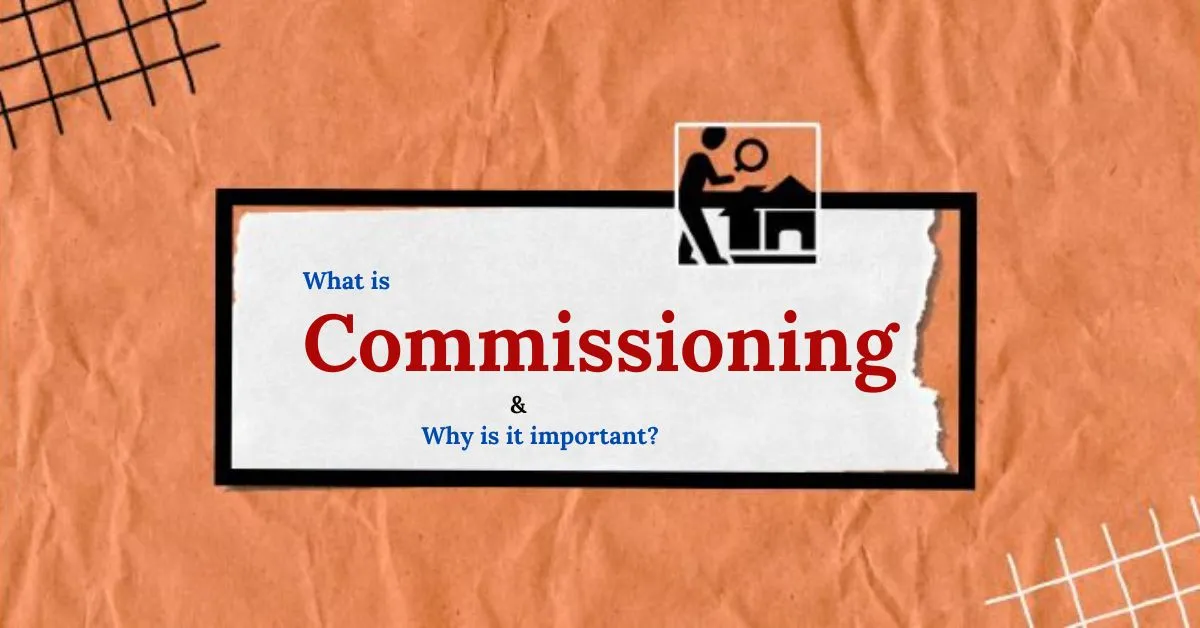
What is Commissioning and Why is It Necessary for Businesses?
Imagine you have just completed constructing a building and are ready to launch your business. Would you start operations immediately without verifying the building’s functionality? Or would you prefer to inspect every aspect of your newly constructed facility to ensure everything works perfectly?
You’d likely choose the second option, wouldn’t you? This critical process is called commissioning, the final phase of a construction project. It ensures that all systems and components are fully functional, including:
- Functionality of MEP Services: Verifying the working conditions of mechanical, electrical, and plumbing (MEP) services.
- Machinery Inspection: Checking the functionality of machinery installed in the building.
- Overall Building Elements: Ensuring that every element of the constructed building is in working condition.
- Safety Systems: Verifying the effectiveness of safety systems such as fire alarms, emergency exits, and other security measures.
- Compliance with Regulations: Ensuring that the construction project adheres to all relevant regulations and building codes.
- Environmental Considerations: Checking for any environmental impact and implementing necessary measures.
The Role of Commissioning in Businesses
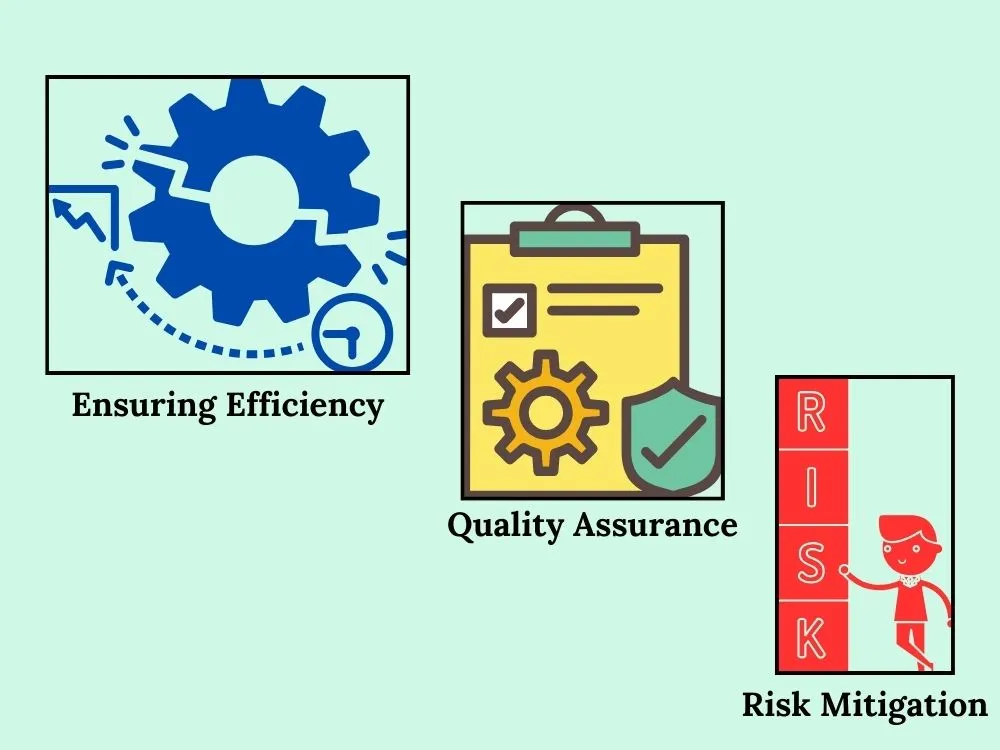
A) Ensuring Efficiency
Avoiding commissioning is like jumpstarting the business operation without checking the functionality of the newly constructed building. Also, missing this crucial part leads to operational issues and impacts the overall efficiency.
Therefore, to ensure efficiency, commissioning is inevitable. It thoroughly checks the functionality of every system in the building to ensure smooth operation and fewer breakdowns. Also, it streamlines the processes for optimal performance.
B) Quality Assurance
Commissioning doesn’t only check the system functionality but it also makes sure the building and its elements are adhered to the quality standards. This way it ensures a standard project handover to the client.
The quality of the building and its systems determine the standard of the business. When commissioning ensures quality, the overall operational standards and service provision of a business become positive. This creates a viable and trusted business entity.
Moreover, quality assurance maintains high standards in products or services. It helps businesses expand their market and reach more potential customers. Also, the overall reputation of the business increases when the quality parameters are concerned.
C) Risk Mitigation
It is a critical part of the commissioning process to verify the safety of all systems and components of a constructed building. By doing this, it effectively mitigates the risk presence and safeguards the building and its occupants.
Further, ensuring safety through mitigating risk is essential to improve workplace wellbeing. Plus, it will increase the productivity of the employees. Complete risk control isn't practical but mitigating the impacts can be possible through an effective commissioning process.
Types of Commissioning
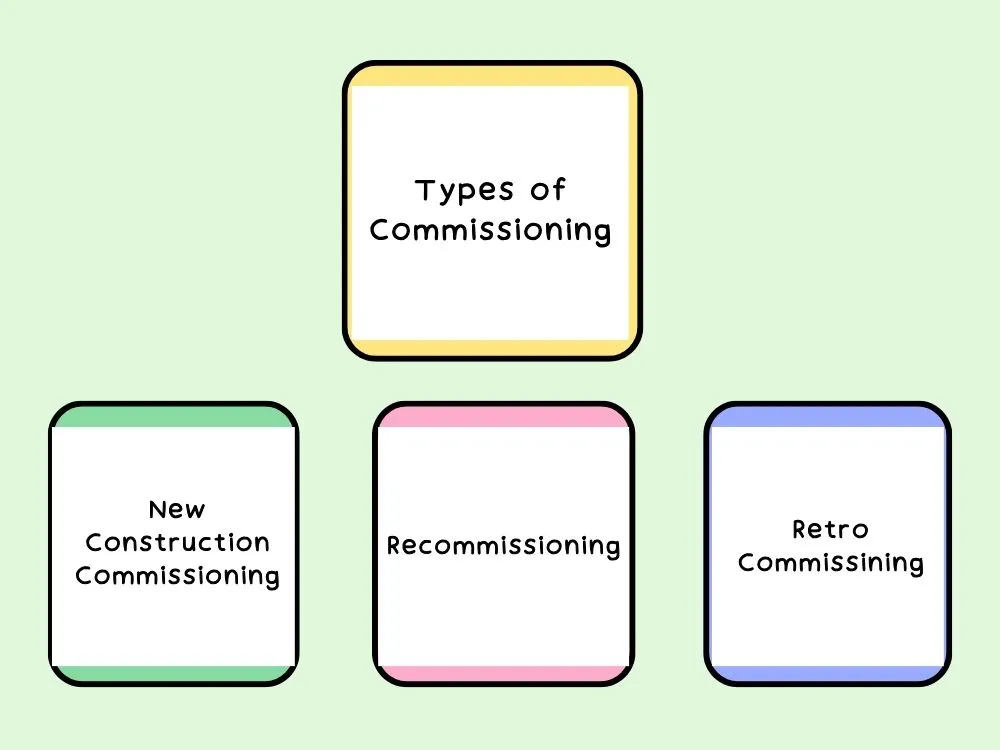
A) New Construction Commissioning
This type of commissioning involves a comprehensive assessment of mechanical, electrical, and plumbing (MEP) systems, machinery, and the overall elements of a building that is newly constructed.
Generally, this new construction commissioning is performed with rigorous testing of each system. This guarantees everything working properly and ensures optimum performance before handing over the project to the client. Simply, this process ensures a fully functional building that makes the client happy.
B) Recommissioning
The recommissioning is the process of conducting a commissioning for a building that was already commissioned previously. This process is required when certain changes in building usage, technological advancements, and business inactivity for a prolonged period happen.
Further, certain refurbishment works, equipment changes, new machinery purchases, or ownership changes also trigger this process. Conducting recommissioning means checking again the MEP services and all vital features in the building to ensure operation functionality.
This type of commissioning mainly involves identifying the common problems in the system, addressing any performance gaps, and implementing proper measures to enhance the overall functionality.
C) Retro-Commissioning
Retro-commissioning is a process that aims to enhance the existing buildings and systems' performance which are particularly older structures that may not meet current efficiency standards.
A comprehensive evaluation is carried out on the building systems which includes all mechanical, electrical, and plumbing (MEP) services. The objective of this type of commissioning is to identify and address any inefficiencies, upgrade outdated equipment, and ensure that the building operates at its maximum efficiency.
Retro-commissioning is a kind of retrofitting process that offers new life to the aging infrastructure to align it with modern standards.
D) Differences Between New Construction Commissioning, Recommissioning and Retro-Commissioning
All of these commissioning processes have a common goal which is to enhance the building and its systems functionality.
Table 01: Differences Between Commissioning Types. On smaller devices, such as mobile phones, swipe or scroll to the right to view all columns.
| Aspect | New Construction Commissioning | Recommissioning | Retro-Commissioning |
|---|---|---|---|
| Purpose | Ensure proper functioning of the new building & its systems | Optimize existing systems for efficiency | Enhance the performance of aging building systems |
| Timing of Implementation | Conducted before the building handover | Performed periodically when there is a change | Performed when the building ages or if necessary |
| Frequency | One time process for new construction | More than one time. Conducted on already commissioned building | Typically, a time process. This may subject to change |
| Scope of Work | Comprehensive, covering all new components | Focuses on existing systems and components | Target existing systems with a broad approach |
| Primary Goals | Verification of design and functionality | Optimization for improved performance | Improves energy efficiency and functionality |
| Common Triggers | Project completion or before occupancy | Changes in facility use, upgrades, or issues | High energy consumption or occupant discomfort |
This table serves as a concise guide for understanding how these commissioning processes differ and the specific scenarios in which each is applicable. By highlighting their unique goals and triggers, it becomes easier to determine the appropriate commissioning strategy for maintaining or enhancing building performance.
Key Components of Commissioning
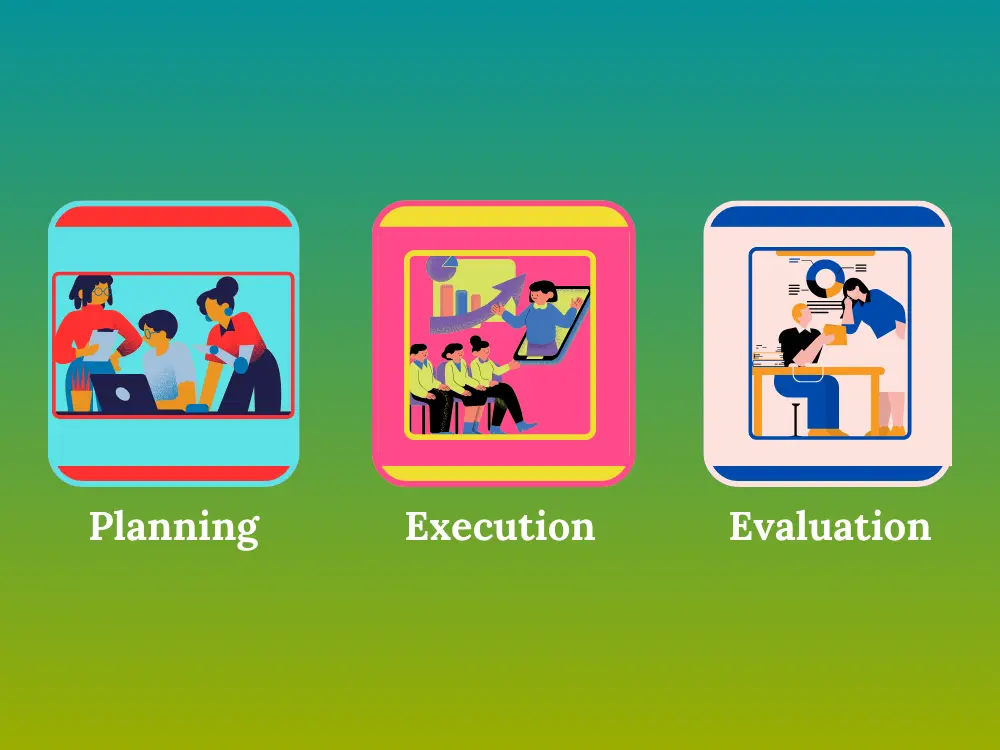
A) Planning
Planning is the initial stage every commissioning process should start with. Strategically planning everything, from the timeline to complex challenges can help execute a successful commissioning process.
Strategic planning involves certain things to consider that support and enhance the outcome of the commissioning process. Here are some essential things to consider:
- Clear Objectives: Define the goals and expected outcomes of the commissioning process.
- Resource Allocation: Identify and allocate human, financial, and technological resources effectively.
- Timeline Development: Create a realistic and structured timeline for the entire commissioning process.
- Risk Assessment: Anticipate potential challenges and develop contingency plans.
- Collaboration Framework: Establish effective communication channels and collaboration frameworks among stakeholders.
- Regulatory Compliance: Ensure that all planning aligns with industry regulations and standards.
These key considerations in the planning stage lay the groundwork for a successful commissioning process that helps boost efficiency, reliability, and overall success.
B) Execution
After successful planning, the next step is to execute the planned stuff accurately. In the execution stage of the commissioning process, every element of the building undergoes a thorough assessment.
This thorough examination of building elements ensures the functionality of every individual system and addresses any anomalies that may arise. Moreover, documentation is a crucial part of this process. It captures the important points necessary to make improvements and corrections.
A collaborative approach is important to execute the commissioning plan successfully. All skilled people such as commissioning providers, industry experts, project managers, design professionals, contractors, and building owners are involved in this process.
C) Evaluation
Evaluation is the last stage of commissioning and it involves assessing the executed stuff with real outcomes and making proper adjustments. This stage is crucial to ensure that the already implemented things in the planning and execution stages work well. It includes the following:
- Performance Validation: Rigorously validate the performance of each system and component against the predetermined benchmarks.
- Functional Checks: Conduct comprehensive functional checks to ensure that all elements operate in the expected condition.
- Efficiency Metrics: Evaluate the efficiency metrics established during the planning phase, confirming that they align with the desired outcomes.
- User Training and Familiarization: Provide user training and familiarization that ensures the end-users are equipped to operate and maintain the systems effectively.
- Documentation Review: Review the comprehensive documentation generated during the execution stage which validates its accuracy and completeness.
- Continuous Improvement Feedback: Collect feedback for continuous improvement and allow for the refinement of processes based on real-world experiences.
Benefits of Commissioning for Businesses
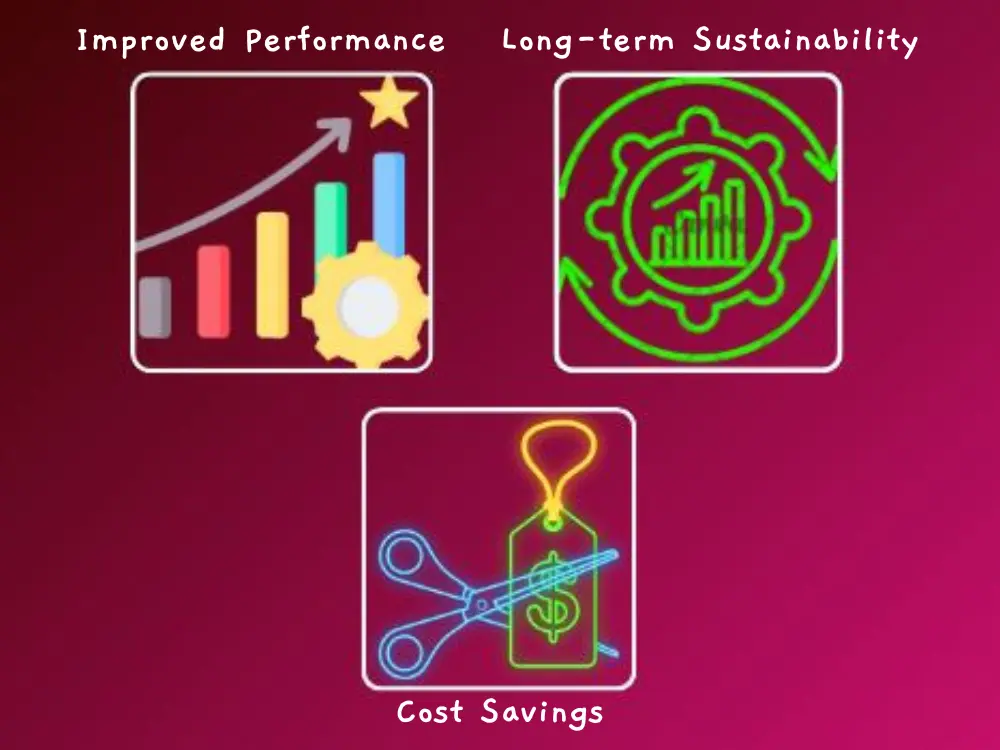
A) Improved Performance
There is no doubt that commissioning improves building performance. It significantly benefits businesses by enhancing overall comfort, well-being, and efficiency. A thoroughly commissioned building enhances productivity and functionality. This helps ensure high employee’ engagement than in a non-commissioned building.
The reasons behind this are, ensuring employee safety, optimum machinery performance, fewer breakdowns, etc. High employee engagement increases their performance and in return results in productivity enhancement.
B) Cost Savings
Beyond the immediate benefit of performance enhancement, commissioning also helps gain competitive cost-saving benefits. An organization gains cost-saving benefits in the following ways through complete commissioning:
- Energy Efficiency: Commissioning helps identify inefficiencies and implement proper energy-saving measures. This leads to significant cost savings over time.
- Equipment Lifecycle Optimization: Commissioning ensures a longer equipment lifespan and reduces long-term costs.
- Preventing Unplanned Downtime Costs: Commissioning can be a preventative measure that helps avoid unplanned downtimes. It saves costs associated with emergency repairs, replacements, and potential loss of productivity.
- Streamlined Maintenance Costs: By maintaining systems proactively, businesses can predict and prevent issues. This is vital to save money on facility maintenance and unnecessary repairs.
- Resource Allocation Efficiency: Commissioning optimizes resource allocation that ensures financial investments align with actual operational needs. Plus, it prevents unnecessary expenditures on overcapacity or redundant systems.
- Identifying Process Inefficiencies: The commissioning process involves examining processes to identify inefficiencies that inflate operational costs. Addressing these inefficiencies leads to targeted cost reduction.
C) Long-Term Sustainability
If there are frequent breakdowns, it may lead to temporary or permanent shutdowns which affect the operation and business income. But when there is a commissioning process involved, it will reduce the issues related to functionality or operations. This improves business continuity and sustainability.
Every business thrives to sustain for a longer term where frequent breakdowns or operational issues are a nightmare for companies. A commissioning process is critical to make sure everything is okay and good to go.
With this process, businesses can able to sustain prolonged periods and it helps enhance efficiency, reduce operational hassles, ensure safety, and many more.
Challenges and Solutions in Commissioning
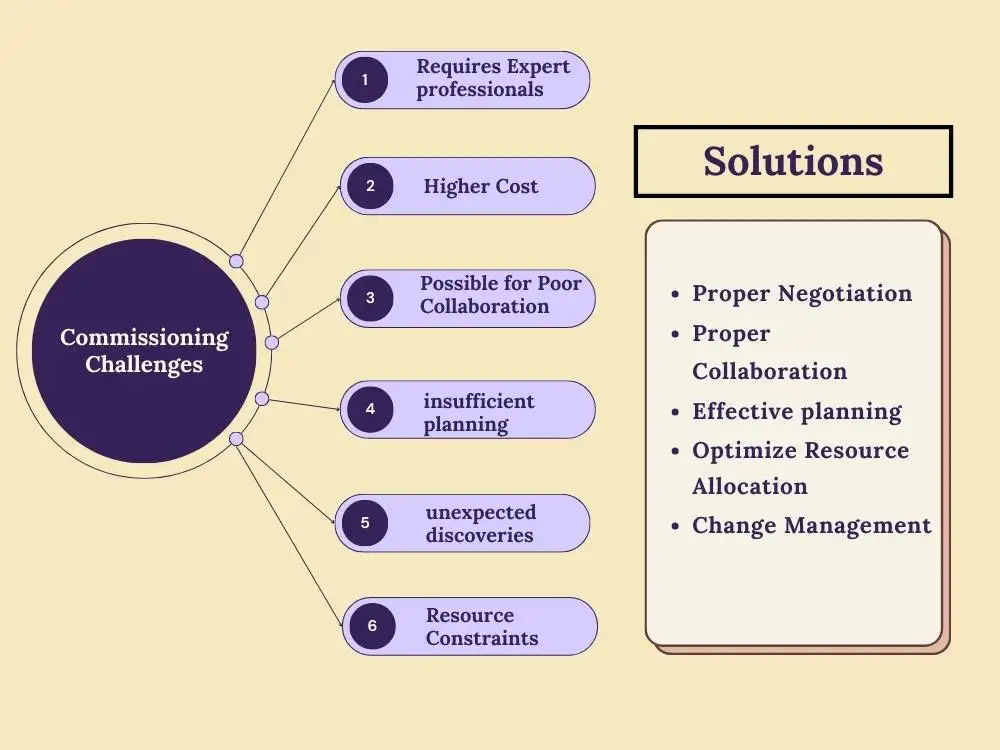
A) Common Challenges Faced in The Commissioning Process
The commissioning is inevitably important whether it’s a new, aged, or altered facility but the process isn’t as smooth and easy as you think. There can be certain challenges in the commissioning process that have to be considered.
Generally, commissioning requires experienced and expert people who are not cheap. So, businesses need to spend a good chunk of money on commissioning providers. Also, poor collaboration can make things worse.
There are other challenges such as insufficient planning, unexpected discoveries, resource constraints, technological issues, and so on.
B) Solutions to Overcome Challenges and Ensure Successful Commissioning
When there are challenges, they do have solutions. So, it is necessary to implement strategic solutions to overcome the challenges in the commissioning process and ensure a successful commissioning.
Different solutions are applicable such as proper negotiation that brings down higher commissioning charges, proper collaboration, effective planning, optimizing resource allocation, change management, and many others.
The following table clearly shows common challenges and solutions for commissioning. A clear picture to understand easily:
Table 02: Commissioning Challenges and Solutions
| Challenges | Description | Solutions | Description |
|---|---|---|---|
| Insufficient Planning | Inadequate strategic planning may lead to unclear objectives, resource misallocation, and an unstructured timeline. | Comprehensive planning | Prioritize detailed planning to ensure clear objectives, resource alignment, and a well-structured timeline. |
| Poor Collaboration | Ineffective communication and collaboration among stakeholders. | Enhanced Collaboration Framework | Implement open communication channels and collaboration frameworks that ensure all stakeholders are aligned with the commissioning plan. |
| Unexpected Discoveries | Unforeseen issues during the execution phase disrupted the commissioning process and demanded swift resolution. | Flexible Execution Strategies | Embrace flexibility in execution strategies to address unexpected discoveries promptly. |
| Resource Constraints | Limited resources whether financial or human. | Optimized Resource Allocation | Efficiently allocate resources based on project needs, optimizing testing, adjustments, and documentation process. |
| High Commissioning Fees | Commissioning experts charge a good chunk of money. | Proper Negotiation | A good negotiation with commissioning providers can bring the charges down. |
| Resistance to Change | Employee resistance to new processes or technologies poses challenges in the execution and optimization stages. | Change management | Implement effective change management strategies to address employee concerns, ensuring a smooth transition. |
Case Study Example
Inno Tech Dynamics is a specialized cutting-edge technology solution that recognizes the crucial role of commissioning in ensuring the peak functionality of its new facility.
Company Overview
- Name: Inno Tech Dynamics
- Industry: Technology
- Location: Silicon Valley, USA
Goals
- Ensure Optimal Functionality: Verify the seamless operation of MEP services, advanced research equipment, and all building elements.
- Adhere to Quality Standards: Elevate the project by ensuring adherence to industry-leading quality standards.
- Mitigate Risks: Prioritize safety through rigorous testing, minimizing risks, and ensuring a secure environment for research activities.
Challenges Faced in Commissioning
- High Initial Commissioning Costs: Engaging top-tier commissioning providers resulted in an initial investment of $750,000.
- Collaboration Challenges: Ineffective communication among diverse teams complicated the commissioning process.
- Unforeseen Discoveries During Execution: Unexpected issues during the execution phase demanded quick resolution that caused minor delays.
- Resource Constraints: Limited financial and human resources posed challenges in conducting thorough testing and adjustments.
- Employee Resistance to Change: The introduction of new safety protocols faced resistance and affected the execution of the commissioning plan.
Strategies Implemented
- Cost Negotiation for Savings: Negotiated with commissioning providers to successfully reduce initial costs by 20%.
- Enhanced Collaboration Frameworks: Implemented advanced communication tools to improve collaboration efficiency by 30%.
- Flexible Execution Strategies: Employed agile execution strategies to address unforeseen discoveries promptly and to minimize downtime.
- Optimized Resource Allocation: Efficiently allocated resources to optimize testing and adjustments.
- Change Management Success: Implemented an engaging change management program to reduce employee resistance by 35%.
Results Obtained
- Cost Savings: Successful negotiation led to a cost reduction of $150,000 and optimized resource allocation reduced additional costs by $40,000.
- Streamlined Collaboration: Enhanced collaboration frameworks improved efficiency and translated to an estimated $75,000 in saved man-hours.
- Efficient Execution: Flexible execution strategies minimized downtime, potentially saving $50,000 in lost productivity.
- Employee Engagement: Successful change management efforts improved employee engagement and potentially saved $60,000 in reduced turnover costs.
- Long-Term Sustainability: Successful commissioning ensured a secure and efficient facility that contributes to the long-term sustainability of Inno Tech Dynamics.
Lessons Learned from Businesses That Neglected Commissioning
Many businesses neglected the crucial commissioning phase and jumpstarted their operations. They frequently encountered many challenges such as unexpected system failures, safety breaches, and inefficient processes.
It would have been totally easy to spot and deal with these complex issues if they had just done the proper commissioning. These experiences from the businesses that neglected the crucial commissioning process teach us a good lesson about how important the process is to make things run smoother in a building, keeping the system reliable and preventing possible issues.
Wrapping Up
The commissioning is a very important phase that every building should go through. This process benefits an organization by maximizing the performance of systems and components of a building. It involves thorough checks of every element in a building and ensures functionality.
This includes MEP services, safety, machinery inspection, and so on. Also, commissioning plays a diverse role in businesses that ensures efficiency, improves quality, and mitigates risk. Commissioning involves a sequence of steps known as planning, executing, and evaluating.
In each stage, commissioning faces multiple challenges, and implementing proper solutions helps eliminate them successfully. Further, commissioning provides significant benefits to a business such as improved performance, increased cost savings and ensure long-term sustainability.
FAQs
Q1: Why is commissioning important for businesses?
Commissioning is important because it ensures efficiency, quality, and risk mitigation. It benefits businesses by improving performance, saving costs, and ensuring long-term sustainability.
Q2: What are the types of commissioning?
There are 03 main types. New Construction (for new buildings), Recommissioning (for changes or upgrades), and Retro-Commissioning (for older structures).
Q3: What are the key components of the commissioning process?
The process involves planning (setting goals and resources), execution (thorough assessment and collaboration), and evaluation (checking performance and continuous improvement).
Q4: How can businesses overcome commissioning challenges?
Businesses can overcome challenges by negotiating costs, improving collaboration, being flexible in execution, optimizing resources, and effectively managing change.
Explore Related Posts
https://smarttoolsai.com/post/length-converter-in-apparel-construction-and-other-key-industries
https://smarttoolsai.com/post/food-and-beverage-industry-and-electric-unit-converters
.webp)